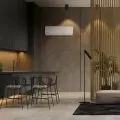A&B: Then what do architects in Poland do for a living?
Matthew: That's a great question! From the calculations above, it seems that in order to earn anything in this profession, one must, for example, reduce the number of hours spent on a project, and therefore reduce its quality.
You can also cut costs in an illegal way - by not paying taxes, using illegal software, saving on salaries, relying on the work of interns instead of experienced architects. The possibilities are many.
One can also support oneself with additional income in the form of commissions, which is, of course, considered unethical in the architect's code.
One can try to raise the rate for a project well above what the market says.
Catherine: All of this is unacceptable from our perspective. And yet it has to be a standard in the market.
Matthew: Many of us cope by setting up additional businesses related to the architectural practice, such as a carpentry shop or contractors. But should this be the case? Do we have the time for that? Shouldn't we do the work we are prepared and educated for, and leave the realization of furniture to carpenters?
Catherine: The biggest problem and the element that disturbs the market is the issue of wages for workers. There is a shortage of educated architects in the studios because we can't meet their financial expectations. It is more profitable for everyone to set up their own studio and start by undercutting their rates to break through in the market. The circle closes again. From social networks pours the heebie-jeebies on the owners of architectural offices for the proposed salaries. But what are they supposed to pay more from? Sometimes I don't want to believe when I read that someone takes 12 thousand for the design of a 150-square-meter house with trades. With good winds such a project is done two months. So that's an income of 6 thousand a month. Deducting Social Security and taxes from this, there will be just over 2 thousand left on hand. From this you have to pay the industries, a possible employee, pay for programs and maintain yourself. Perhaps I'm bad at math - but this has no chance of working out.
Even if there is one such project for each person in the company, there is 2200 left for a salary (with an employment contract), so you have to have something to pay for this salary from. If an employee can't earn his or her job with a surplus so that the company has a way to grow, then something is wrong. And it's not the employee's fault. It's the fault of a flawed system for calculating project fees.
I dare say that the profession of architecture is one of the lowest paid professions in our country. A profession requiring many years of study, a profession of public trust, requiring technical knowledge has been pushed to the bottom of the salary scale. For that, we still enjoy very high public respect and trust.
A&B: So what is the way out of the situation?
Katherine: The area-based billing of labor is in fact a lump-sum billing. We know very well what the client's mechanism is in such a case. Since he paid, he demands. Since he can see five versions of the project, why should he stop at the first one, add that one he likes? Maybe the other four will be even more interesting?
This is exactly how a flat rate for water used to work. We would sit in the bathtub, the water would pour, and we would adjust the level with our heel and lie there for two hours without losing temperature. Or flat rate heating, when the radiators heated to the max and you opened the windows if it got too hot. Or the all-you-can-eat system - I paid, so rent for three, because I can.
The client wants to know how much the project will cost, but how do we know that without knowing the client? Perhaps much less than the calculated rate per square meter, perhaps twice as much. At the moment it all depends on the client.
Matthew: We came to the conclusion that the solution to our problem can be drawn from other public trust professions. Why not reverse the situation and switch to hourly billing? This makes things extremely easy. We determine how much revenue a studio needs to bring in per hour in order to start earning, and we determine the rate per project based on that.
This solution is definitely fairer for both parties than a flat rate. The client pays exactly for the work we do. Neither more nor less. In the case of a lump sum, the more demanding client is the one we are adding to, and the more organized, quick decision maker, who does not expect multiple project variations, theoretically overpays. And it should be the other way around, after all.
Catherine: Believe me, since the introduction of hourly billing in our studios, the time spent working on a project has reduced from ten hours to a maximum of three hours per square meter. Most often it is more or less two hours. The client at the moment does not make unnecessary moves. He respects not so much our time as his money. He still gets a top-notch project, tailored to his needs and meeting his goals and budget, but he comes to us better prepared and focused. And we no longer get calls asking for information that can be found in the documentation if you just open it.
A&B: Does this provide any more benefits?
Matthew: One of the main problems for architects is the lack of liquidity that comes from not being able to predict when they will receive payment from the client. This is because it involves the closing of specific project milestones, which is not always up to him. Hourly billing means that we can accurately predict and plan what amounts will be invoiced at the end of the month. Working hours are monitored by a specialized program, from which statements and reports can be generated summarizing the number of hours worked on a given project in a great many configurations. Working in this way, it is easier to expand the company, talk about salaries or forms of employment. As in any business, the role of the owner should not be that of an employee, but that of a mentor and a person who looks ahead several years with plans and focuses on acquiring clients. Until now, this has not been the case, as the owner is the one who has had the most work and has had to "contribute" to employee salaries. Totally absurd in a business context.
Catherine: Restoring prestige and respect for the architectural profession and the work it does is another very big plus of this system. Our priority is to bring about a situation where not only the owner of the studio and the chief architect will earn well, but also all the architects we employ will be able to earn solid money, when we can afford to make employment contracts the standard, and it will not be an insurmountable issue for us financially. It is really sad when we know that salaries in architecture are lower than the so often cited salaries at the cash register in a discount store. Once again, I will emphasize that these are people after five years of study, often with years of practice, and each of them is an above-average person. It has come to an absurd situation - we discourage young people from going into architecture. Due to the overabundance of studios, it is very difficult to make a name for yourself, and on top of that, it is very hard to make a living. This is not funny, but true: architects work 12-14 hours a day. This was our reality for inches, until we finally came to the conclusion that it can't go on like this, that the only salvation is to change the business approach.
A&B: Do customers accept this way of billing?
Matthew: Of course, it varies sometimes. There are customers who have no comments on this type of billing and accept it right away, admitting that it is fair. However, there are also those who want to know in advance how much they will pay for a project. However, this is a matter of argumentation. We reply that it is up to them, not us. We know how much it will take us to do the project, but we don't know how many changes the client will make. More than once there were clients who made changes already after the project was handed over, which involved changing not only the concept, but also visualization, technical documentation. Billing by the square meter, it is difficult to predict and price such changes. It remains to grit one's teeth and introduce them within the predetermined price.
Catherine: My favorite example I give clients in such situations is a simple service of painting a room. Imagine that Mr. Smith hires a painter who quotes a flat rate for the service of painting the walls. After agreeing on a color with the client, the painter does his job, and then the client comes in and says, however, that this color doesn't suit him and asks to paint it another color. To show the abstractness of our profession, we can go further: the second color does not suit Kowalski either, the third also, and in the end, however, he concludes that the first one was the best and asks to paint a fourth time. According to the principle "I demand until I am satisfied and sure that this is exactly what I expected". Does anyone know a painter who will agree to this?
Matthew: Fortunately, the change has begun. We are no longer the only studios that have introduced this billing system. Within the SAW association, several studios are already using it, and more are moving towards it. Therefore, we are of good cheer and encourage everyone to think about it. In our opinion, there is no other way. All over the world, an architect is a person of respect and it is one of the best-paid professions. Let's wake up! Let's start valuing our work realistically. Let's make it count!
Catherine: We are aware that in some sense we are opening a Pandora's box, but we should not continue to be silent, pretending that it is good. It's not good. It's very bad and it's time to change it!
A&B: Thank you for the interview!
Catherine, Matthew: Thank you!
***
Mateusz Kuo Stolarski - founder and chief architect at Tamizo Architects. Graduate of the Faculty of Architecture at the Technical University of Lodz. For his 2004 diploma project he was awarded first prize in the Concrete Architecture Diploma of the Year competition and honorable mention in the SARP Diploma of the Year competition. Since November 2009, he has been a member of the board of directors of the Łódź branch of SARP (Association of Polish Architects). He is also a founding member and board member of SAW (Society of Interior Designers). In addition to architecture, he is passionate about industrial design, graphic design, typography, photography.
Katarzyna Kuo Stolarska - a graduate of architecture and urban planning at the Technical University of Lodz. From 2000 to 2007 she created projects in her own studio Rydzyńska Studio, from 2006 to 2012 she ran Rydzyńska Design studio, which for nine years has been operating under the new name KUOO Architects. She co-founded the Society of Interior Designers (SAW).














